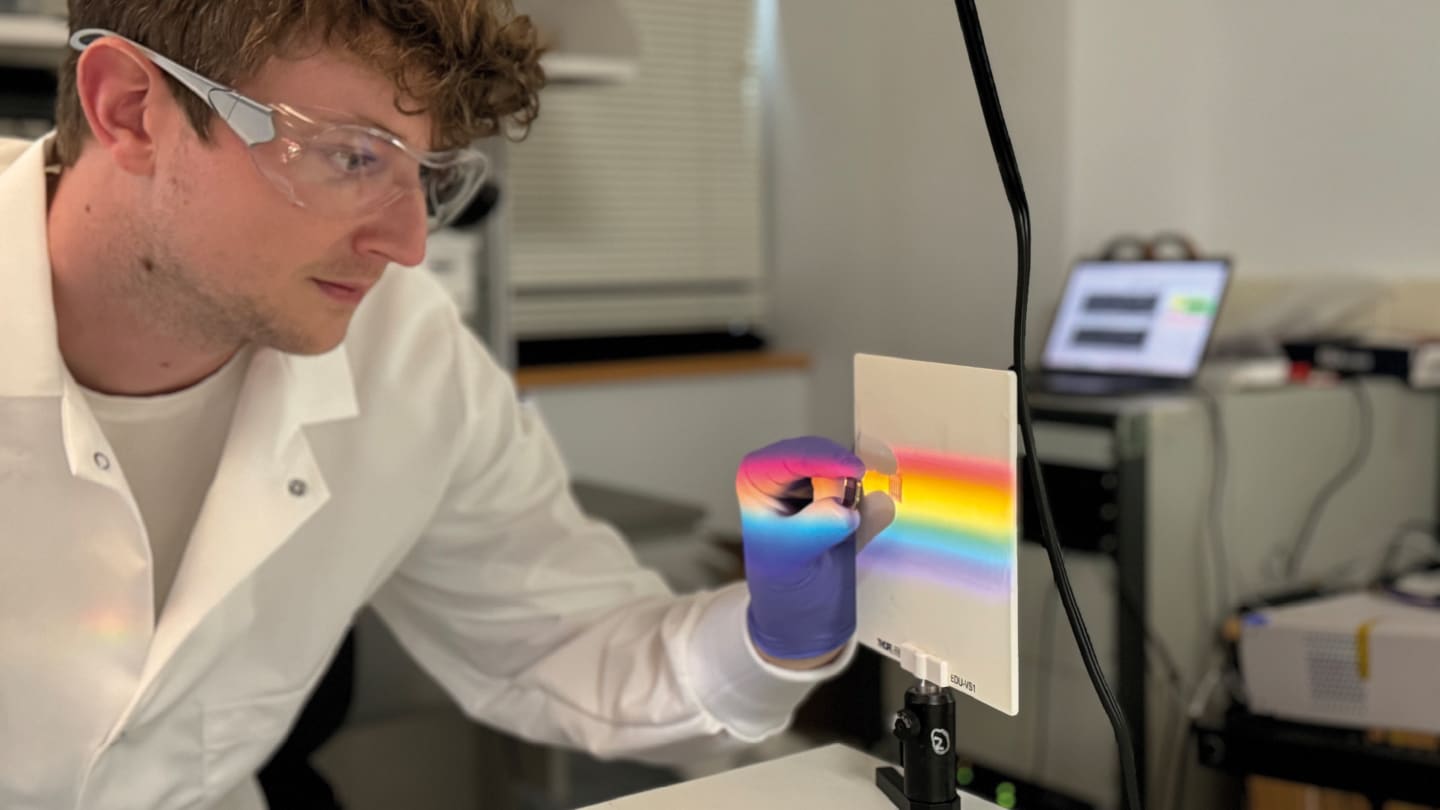A spectrometer just a few square millimeters in size could soon bring hyperspectral imaging to devices as small as a smartphone camera. Developed at North Carolina State University, the bias-tunable tandem organic photodetector covers wavelengths from 400 to 1,000 nm, resolving peaks to within 0.18 nm while operating at less than one volt. The single-pixel design eliminates bulky optical components, making it simple to fabricate and integrate into arrays for portable or on-chip applications. Published in Device, the work shows how a compact organic architecture can match commercial performance in both narrow- and broadband light reconstruction.
Here, senior author Brendan O’Connor discusses the origins of the design, its first-try success, and how it could lead to imaging spectrometers for manufacturing, diagnostics, and consumer devices.
What first sparked the idea for this work?
We were working on polarization-sensitive detectors when we realized polarization could be used for color selectivity in a photodetector design. This led to our 2021 work in Science Advances. However, achieving hyperspectral detection with that design resulted in a rather complex device stack, so our work was already circling the periphery of miniaturized spectrometer concepts.
A review in Science on miniaturizing spectrometers – particularly its discussion of reconstruction spectrometers – inspired us to explore how we could achieve this using organic detectors. This ultimately led us to the design described in our current paper.
Interestingly, after we designed and tested our device, we discovered older work on amorphous silicon detectors using a similar back-to-back diode structure, though not for spectral detection – rather, for two- or three-color sensing. We also found related work using organic semiconductors, again only for two-color detection.
Our design is distinct in that the materials within the cell were specifically chosen and implemented to enable spectrometer functionality. Nevertheless, it is interesting that the concept of back-to-back diodes as a device engineering strategy has been considered in the past.
Can you briefly explain how the technology works – in a way that someone outside the field might understand?
The zoomed-out view is that we have a photodetector with a unique spectral photosensitivity at a given applied voltage across the device. By measuring the photocurrent generated as you sweep over a voltage band, you can reconstruct the spectrum of the light source that was just measured. In our case, the voltage sweep is relatively small, from about -0.8 to 0.2 V.
The way we get the unique photoresponse is by stacking two photo-sensitive cells on top of each other (in a tandem), designed so that the efficiency of charge extraction from each cell depends on the applied voltage. Each cell has a unique spectral absorption character, but with some overlapping spectral absorption. This combination of unique but overlapping spectral absorption from each cell allows you to back-calculate (reconstruct) the spectrum of the incoming light source once the detector is calibrated or trained.

What was the biggest challenge in developing a spectrometer at such a small scale – and how did you overcome it?
What’s nice about this design is that it is a single photodetector with two terminals and a relatively simple stack to fabricate. This overcomes the challenge of other miniaturized spectrometers that use dispersive optics and filters, which, by nature, require space to work effectively. The design introduced here removes the need for additional optical elements. There is not a large fabrication barrier to scaling down the detector. In fact, years ago I was part of a team that fabricated organic photodetectors on AFM tips – just one example of scaling down. The detector design here is not much more challenging to fabricate than any other conventional organic photodetector, so scaling down should not be a problem.
Also, the stack is not too different from an OLED, and fabricating an array would be similar to the fabrication of OLED displays. We would want an array to make an imaging spectrometer – which will be a part of our future efforts. To get an array for an imaging spectrometer, we would just need patterning processes similar to those used for CCD camera backplanes or OLED displays – in theory.
Would it be accurate to call this “the world’s smallest spectrometer”?
That’s a good question. There have been a couple of other recent demonstrations of reconstruction spectrometers using a single photodetector. We think our design has a number of advantages, with performance comparisons given in Table S2 of the paper. I’m not sure if ours is the smallest demonstration, but it is certainly among the smallest. We could also scale down the size further. The key would be to put the detectors into a form factor suitable for an array for imaging, similar to a CCD. There is no size barrier to getting there.
Did any of the results surprise you? When you began, did you believe this level of miniaturization was really achievable?
The “eureka” moment may have been when we realized that the design had a real chance of working. We sketched out the tandem detector design with “back-to-back” diodes and thought it should work. But probably the most surprising thing was that, after the first device fabrication, we saw results that already showed the design would work.
It wasn’t so much the size – we knew that would not be the barrier. The key was to see how the responsivity would change with voltage. There was a chance the responsivity would not change spectrally, or if it did, it might simply toggle between two spectra (which would be insufficient), or that it wouldn’t be high enough across the applied voltage range. All of these were possibilities when we started.
That’s why it was incredible to see it work practically on the first attempt. For us, this was very surprising, as we usually have to tweak the design and processing approach over months to get detectors with the properties we’re targeting. A lot of credit goes to the first author, Harry Schrickx, who has an excellent knack for device fabrication.
What kinds of applications do you envision for this technology – and is there one you’re especially excited about?
Achieving an imaging spectrometer is the next goal – specifically, one the size of a CCD used in consumer cameras, such as those in smartphones. Once this is accomplished, we believe there will be a whole range of possible applications: from laboratory use (for example, attached to a microscope) to manufacturing quality control, health monitoring, and other biosensing applications.
The spectral information from a target material provides a wealth of insights. In consumer products, it could be used to assess skin conditions, detect spoiled food, or identify early stages of plant disease. It’s exciting to think about putting a powerful piece of equipment – usually confined to research laboratories – into people’s hands. One could monitor emissions from car exhaust, verify safer dyes in food and clothing, and a lot more. I’m sure there will be many uses I haven’t even considered yet.
What’s next for this work?
Scientifically, there’s still more we can do to improve performance – broadening the spectral sensitivity, increasing speed, and refining the reconstruction algorithm for greater precision. As mentioned, a key goal is translating this into an array for imaging. We also need to better understand performance across a range of illumination conditions to ensure reliability in real-world scenarios.




